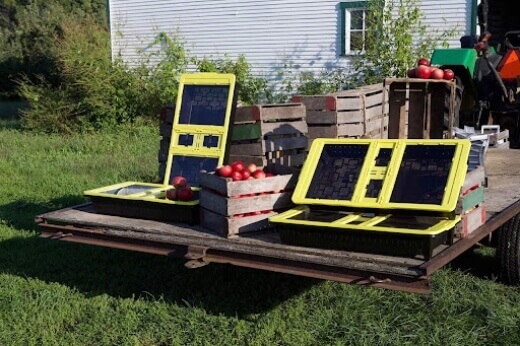In today's world, where food preservation is dominated by industrial methods such as canning and freezing, it's easy to forget about traditional techniques that have been used for centuries.
One such method is sun drying, also known as solar dehydration, which is once again becoming popular thanks to the rise of organic foods and healthy lifestyles. Not only is it a natural way to preserve food, but it also adds unique flavors to dishes.
More...

Introducing Dehytray Solar Dehydrator
JUA Technologies Intl. is bringing back solar dehydration while making it faster and safer using the Dehytray™ Solar Drying Tray. The Dehytray™ speeds up the drying process by acting like a mini-greenhouse - amplifying the heat inside the tray. It also protects the foodstuff from pollen, dust, most insects, and birds.
What is Solar Dehydration?
Solar dehydration is a process that uses the sun's heat to evaporate water from fruits and vegetables, resulting in a concentrated product that can be stored for a long time. This traditional approach is still used today by home gardeners, organic gardeners and homesteaders who want to preserve food for later consumption. This can also be utilized by campers and caravanners.
Developing the Dehytray Solar Dehydrator

Solar dehydration is not just for hobby gardeners, horticulturists and people who grow and preserve their own food. It has the potential to address global food insecurity, and a team at Purdue University led by Dr. Klein Ileleji has developed the Dehytray™, a solar dehydrator designed for this purpose.
Dr. Ileleji grew up in Nigeria and knows the importance of harvest preservation in addressing global food insecurity. While working on a grant to develop a maize dryer in Kenya and Senegal, he found that smallholder farmers and families were more interested in drying fruits, vegetables, herbs, and spices, and that an estimated 50% of these nutritious crops are lost to spoilage each year.
Food security is a complex issue affecting many people worldwide. It refers to the ability of individuals, communities, and countries to access and afford sufficient quantities of nutritious food to maintain a healthy and active life.
Despite the advancements in technology and globalization, millions of people across the globe are still affected by hunger and malnutrition. According to the United Nations Food and Agriculture Organization, over 690 million people, or 9% of the world's population, suffer from chronic hunger, and one in three people suffer from some form of malnutrition.
The issue of food security is not only about the quantity of food produced but also about the quality and accessibility of food. Many people cannot afford or do not have access to healthy, nutritious foods due to poverty, social inequality, conflicts, and natural disasters.

In many developing countries, food security is a significant concern. The increasing population and climate change, coupled with a lack of access to water, arable land, and affordable food, make it difficult for many people to access adequate food.
In sub-Saharan Africa, for example, over 239 million people are undernourished, with over 30% of children under five years of age being stunted. The situation is even worse in conflict-affected regions such as Yemen, South Sudan, and Syria, where millions of people are on the brink of starvation due to ongoing conflicts and displacement.
The COVID-19 pandemic has further exacerbated food insecurity around the world. Lockdowns and other measures put in place to control the spread of the virus have disrupted food supply chains and made it difficult for people to access food.
The pandemic has led to increased poverty, loss of income, and increased food prices, making it challenging for many households to afford sufficient food. According to the World Food Program, the number of people experiencing acute food insecurity could rise to 270 million by the end of 2021, up from 135 million in 2019.
Dr. Ileleji's goal was to make solar dehydrators more accessible, and simple to use, and he and his team have had success making purchases in countries worldwide.


Get Your Free Guide:
Master Growing Australian Natives eBook
A Must Have Complete Guide for Every Australian Garden
Get Your Free Guide:
Master Growing Australian Natives eBook
A Must Have Complete Guide for Every Australian Garden
Through collaborations with subsidiary companies, the Dehytray™ has been exported to over ten countries across four continents. During the COVID-19 pandemic, the Kenyan government purchased 8,000 units in 2021 and distributed them to thousands of families to address household nutrition.
Benefits of Solar Dehydration
The benefits of solar dehydration are clear. Not only is it a natural way to preserve food, but it also adds unique flavors to dishes. You can use solar food drying in a variety of ways, including making potato chips or other nutritious dried snacks that are fun to experiment with, such as apples, pears, peaches, carrot, beans, or beetroot chips and of course, bush tucker.
How to Use the Dehytray Solar Food Dehydrator

With a solar food drying rack, you get to decide exactly what ingredients go into your chips, including preservatives and excessive sodium. Simply slice up your preferred ingredient, season it, and then arrange the slices in the rack. Place the rack in a bright area, and the sun will take care of the rest. This is perfectly suited to Australian conditions.
Check out our full product review of the Dehytray solar dehydrator.
How to Store Dehydrated Food
But how do you store dehydrated food? Because the water content has been removed, dehydrated foods can last for months or even years without spoiling. The key to successful dehydration is to store the food in an airtight container in a cool, dark place.
An ideal storage spot would be a pantry or cupboard that is away from any heat sources. Once the food is properly stored, it can be rehydrated by adding water and allowing it to sit for a few hours.
Dehydrated foods are not only convenient but also nutritious. In fact, dehydration ups the fiber concentration in fruits and vegetables, making them even more nutritious than their fresh counterparts. You have the freedom to season and spice your food as you dry it, preparing nutritious and portable snacks.
The Dehytray™ is extremely versatile: users have made beautiful flower arrangements using it. Other applications include the drying of spices to make spice rubs, drying dates to make stuffed dried date snacks.
The Dehytray™ is soon coming to Australia! Email Luke Clatworthy to learn more.
Make Solar Dehydration Easier by Using the Dehytray Solar Dehydrator
In conclusion, solar dehydration is a traditional technique that is making a comeback in today's world. It's a natural way to preserve food that adds unique flavors to dishes, and it has the potential to address global food insecurity.
Whether you're a home gardener, organic food producer or grower, nutritionist, a researcher, or just someone who loves experimenting with new food preservation techniques, solar dehydration is worth exploring and the amazing Dehytray™ can do this naturally while helping our environment and encouraging food sustainability.
Published on February 23, 2023 by Gary Clarke
Last Updated on January 29, 2024




